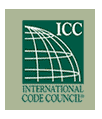Houston - Galveston - Texas Coastal Home Inspections I Coastal Inspector I Infrared Thermography I IRC Code Certified |
||
 |
|||||||
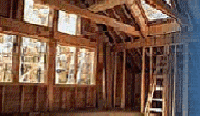 |
 |
||||||
 |
|||||||
.. |
|||||||
 |
|||||||
This is only one defect of many that can be on a roof surface. Most you can't see unless you crawl on the roof. Did your inspector even have a ladder or does he/she just disclaim roof climbs in every inspection as a common practice? There appears to be an inspector out of Pearland, Texas hiding behind some kind false entitlement to not crawl on roofs according to one of my clients. She said he didn't even have a ladder. That's bull. There is no honor in not following state law and the requirements of your business license. If you weren't told ahead of time the roof was not going to be climbed on to be inspected then that's a violation. [ref: TREC 535.227(5)(C)].
Binoculars? Go look at your inspection report. How was your roof inspected? The inspector should be specific on how it was inspected and has to report surfaces that were not accessed.
Take the Challenge
If you are looking for a 1-year builder inspection and/or you had your home previously inspected and have some questions please look at a few examples below and on the next example pages of defects and then go look at your home. If these defects were not caught by your inspector then please don't compare my inspection or fee to what you didn't get. I don't use or invent a pre-determined checklist inspection which limits the inspection to only those items on it. That inspection you may have got doesn't look so good after all does it? You might have hired an inspector thinking they are all the same. Nope, there is a huge difference. A construction inspector should be full code certified (some are only partially certified) whereas the Texas Real Estate Commission (TREC) does not require any home inspectors to be code certified. Take the Challenge. Below are just a few examples of basic items. (There's plenty more too.)
You may be gambling with your family's largest investment on a inexperienced home inspector just as you would with a cheap built structure or electrical system. What your inspector didn't tell you about your home could be serious.
Take the Challenge. A owner might never know how good or bad an inspection they got because buying a home is not a everyday occurrence for them.
If you expect your home inspector to be knowledgeable in building codes then wouldn't you expect he or she to be full code certified? Builders and contractors generally ask for the code section on the item your inspector is referencing. Why? It's a professional courtesy and they are trying to sort out inspector personal preferences from codification. But, on the other hand go to a construction trailer or office and ask to see a code book. Let me know if you find one. For that matter if your inspection had no references to any codes then that may be a red flag. A inspectors opinion is not the golden goose and without legitimate references for a given item it may only be a personal preference.
If you are buying a new home or doing under construction inspections or needing a 1-year warranty inspection and your inspector is not full ICC code certified then what are you getting?
How can one comply with the resale/used home standards that according to the state that......."more accurately reflect current technology, codes, and practices that form the basis of many of the standards" unless one is code certified?
Unfortunately there are loopholes in any minimum qualification requirements and your expectations so I recommend the combination home inspector who is also code certified that you probably won't find on a "favorite inspector list".
Limited Offer - One can always call for free advise on a code or property question but for a limited time only if you are within my immediate service area you can get a free 30 minute onsite evaluation if you had your home previously inspected within the last two years and are wondering about what you got or having problems. No pressure. No sales. If at a later date you need information, an inspection, a second opinion I'm hoping you will call me. *Some limitations apply. (No stucco, no aluminum wiring)
These few examples from real everyday inspections are visible and reportable. There's much more and the samples do not imply any more importance over other defects.
- References to (TREC) sections are the state law requirement of your inspector to inspect for and report.
- References to (IRC) sections are the minimum statewide building codes for construction and repairs.
- Reference to (TRCC) sections are for homes initially enrolled into the TRCC beginning on June 1, 2005 until TRCC quit taking complaints on August 31, 2009 and for the 10-year structural warranty.
Ready? Here we go !
Wall Street Journal - Almost every house, no matter how recently or expertly built, is a money pit. The Wall Street Journal study that found it may be cheaper to buy a new or fully remodeled home every 10 years than to deal with the mounting repair problems of an aging home. Read More
The inner wall cavity of the brick cladding at the weep holes were observed blocked with mortar. This blockage prevents drainage, ventilation and pressure-balancing of the inner wall cavity that can exacerabate moisture intrusion and potential organism growths. - [ref: TREC 535.228(k)(2)(E)(i); IRC R703.7.4.2 Air Space. The brick veneer shall be seprated by an air space of a minimum of a nominal 1 inch. IRC R703.7.6 Weepholes. Weepholes shall be provided in the outside wythe of the masoonry walls at a maximum spacing of 33 inches on center.] [ref: Texas Residential Construction Commission 304.15 (g). Mortar shall not obstruct a functional opening, such as a vent, weep hole or plumbing cleanout. (1) If mortar obstructs a functional opening, the builder shall take such action as is necessary to bring the variance within the standards (aka: fix it.)].
Go outside and look in your weep holes at the bottom of the brick wall or above window and door openings. You might need a flashlight. Every inspector has a flashlight. Is mortar blocking the weep hole or inner wall cavity?
The cavity behind the brick should be clear and open. This is readily visible. Weep holes serve as the drainage, ventilation and pressure-balancing of the inner wall cavity. If they are blocked water can enter into the home and exacerbate mold growth within the wall. Blocked weep holes can cause all kinds of problems.
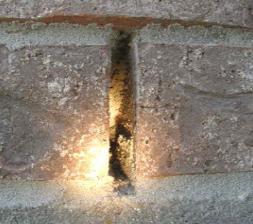
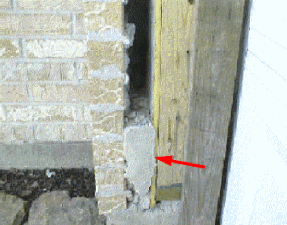
As an example we've seen the inner wall cavity blocked 4 and 5 brick high with mortar. Mortar filled cavities require brick removal along the base of the foundation. If your wall cavity is blocked give me a call at 281-337-4052.
No flashing observed installed above and over the steel lintels to serve as the drainage plane of the inner wall above windows, doors or other openings with brick above. [ref: TREC 535.228(k)(2)(E)(iii); IRC R703.8 Flashing; TRCC 304.11(6)(A)]
Go outside and look. If there is no flashing on top of the steel lintel above a window where the brick sits the windows can leak (and many have) when the brick wall becomes saturated. The flashing should overhang the edge of the steel lintel if it is present and would be easy to see. You should also be able to easily see the flashing material through the weep holes (if they are clean).
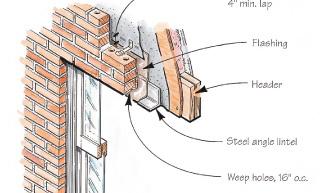
Windows (production type) leak air or water? TREC 535.228(k)(2)(E)(v); IRC R102.4 (ASTM E2112)
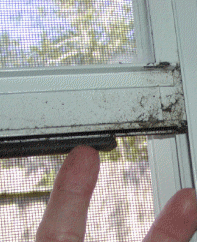
Open your aluminum framed windows and look for this rubber weather-strip in the photo. There are 3 basic window types so look at the photo. Does it extend across the full width of the window sill? If not then the window can leak air and moisture. Production built aluminum windows are not known to be rated to prevent water or air infiltration in any wind speed. Does your inspector know the difference?
A checklist inspection that can pre-determine problems or property condition? Wow. The whole inspection and inspection software industry would love that if it existed. The problem is that it doesn't. That checklist was put together by the individual inspector for items he or she wants to inspect. That checklist determines what someone wants to tell you and nothing more. How do you know it meets the inspection standards? What about items or conditions not on the checklist? There is no way to pre-determine property condition.
Plumbing vent pipe seals rotted out or cracked. [ref: TREC 535.228(e)(2), (3)(B)(v)]. Torn shingles observed. Exposed nails observed in the vent, exhaust flue and flashings. [ref: TREC535.228(e)(3)(B)(iii)].
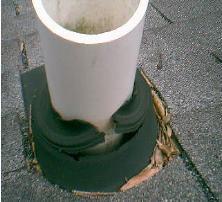
Home inspected in cold weather? If it is less than 60 degrees outside a TREC licensed inspector does not "have to" operate the air-conditioner under the minimum inspection standards. (Operating the A/C in cold weather can damage the system) If your inspector is not so great he most likely won't do anything. However the minimum standards require inspection of the condition of the safety drain pan, pipe insulation, drain lines, air loss sealing, dirt, condenser unit clearances, levelness, mounting and access. The type of system and energy source should be reported. There is more to inspecting an air-conditioning system that turning it on and taking a temperature reading. The inspector can't simply check the "Not Inspected" box on his inspection form and not follow the state inspection standards to make it easy on him or herself because there are plenty of other parts and components that can be inspected and reported upon. Go get your report and see what it says. Nothing?
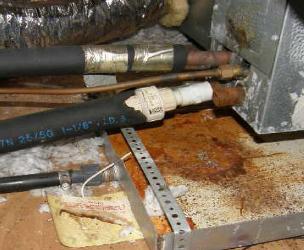
Uninsulated water lines in your attic? Call any pipe manufacturer you want. For decades they have and the code has said to insulate pipes from freezing temperatures. A water, soil or waste pipe shall not be installed outside of a building, in exterior walls, in attics or crawl spaces, or any other place subjected to freezing temperature unless adequate provision is made to protect it from freezing by insulation. [ref: All pipe manufacturers require pipes to be protected from freezing temperatures; Standard Plumbing Code 305.6; CABO 3103.6; Uniform Plumbing Code 609.1; Texas IRC P2603.6]. {Some pipes can freeze even if insulated depending on the temperature}

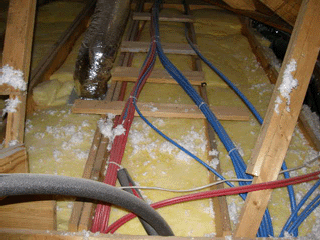
Example: CPVC pipes not insulated in attic
Example: PEX pipes not insulated in attic
